The Premier League was back after the midweek fixtures. The clash between Everton and Chelsea was an intriguing one, as the Toffees sacked Marco Silva after the huge loss in the Merseyside derby. They dropped to the relegation zone before the game. Despite several rumours on the new manager candidates, Duncan Ferguson became the caretaker manager of the team.
Chelsea had a good run in the past two months, they bounced back with a 2-1 victory against Aston Villa in the midweek. Frank Lampard transformed Chelsea into an attacking team, and they looked for a win to consolidate their Champions League qualification spot.
In this tactical analysis, we will show you the tactics of Everton and Chelsea, and how did the Toffees bounce back at the Goodison Park.
Lineups
Ferguson abandoned the formation of Silva, he shifted the formation of the team into a 4-4-2 shape. There were limited choices for the back four, which formed by Lucas Digne, Mason Holgate, Michael Keane and Djibril Sidibé. For the midfielders, Gylfi Sigurðsson and Morgan Schneiderlin partnered at the centre of the pitch. Alex Iwobi and Theo Walcott were the wingers. Richarlison and Dominic Calvert-Lewin started together upfront.
Lampard made some changes to his squad, they played in a 4-2-3-1 formation. Andreas Christensen was given a chance to partnered with Kurt Zouma, as Fikayo Tomori was rested on the bench. Emerson was on the bench as César Azpilicueta played as a left-back.
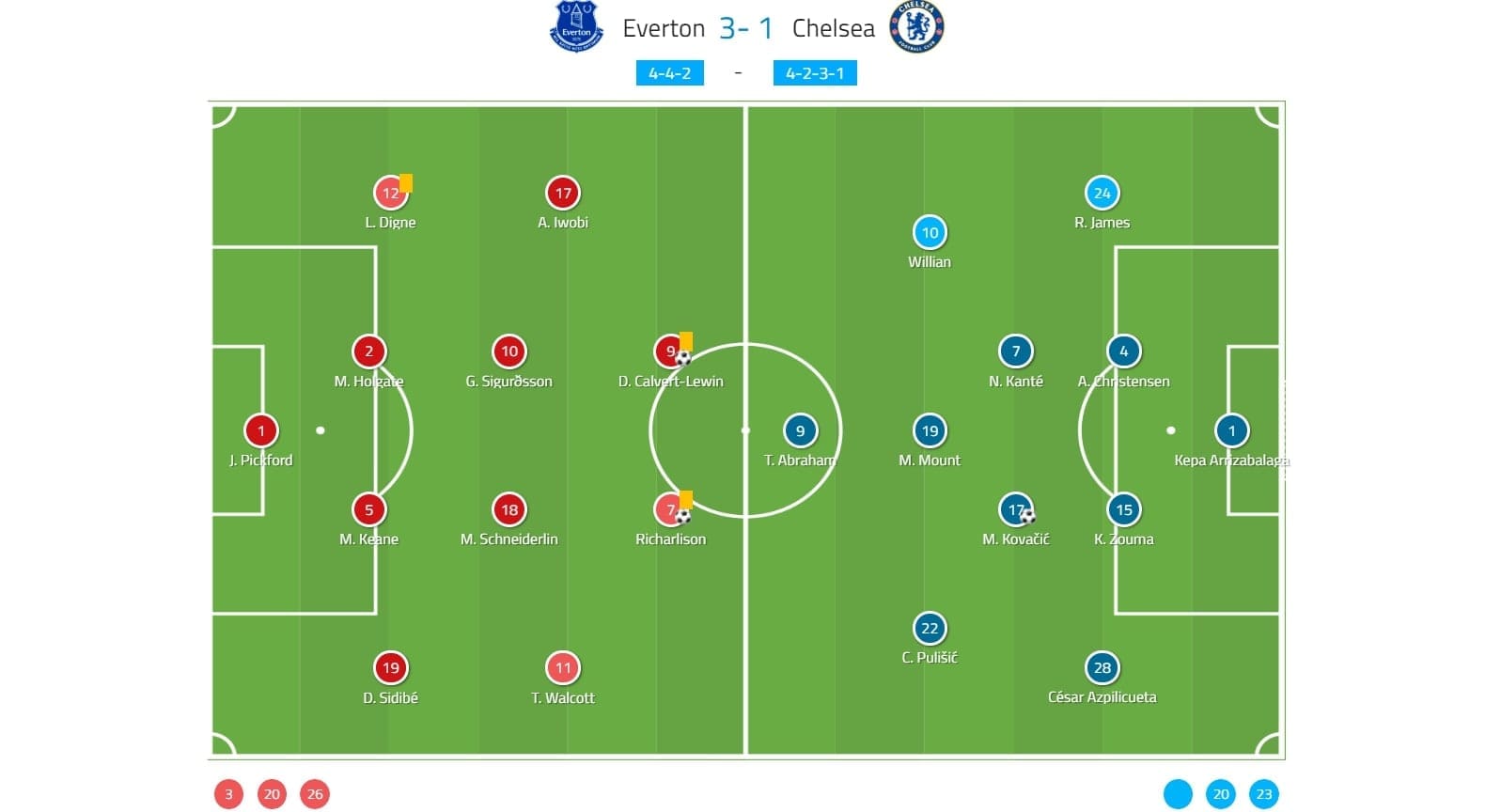
Everton’s defence
In the first part of the analysis, we investigated the defence of Everton. Before the match, the Everton defence was vulnerable, they had conceded 27 already in the league. However, their defence in the first half was solid that Chelsea only got one shot on target; they limited Chelsea at an xG of 0.24 in the first half. In general, they defended with a 4-4-2 midblock. Ferguson did not plan to defend passively, he tried to increase the tempo of the game by ordering his players to press intensively. Chelsea were difficult to break the press and get into the final third if they insisted to play out from the back.
The Everton press was flexible as they had to adjust themselves due to the build-up structure of Chelsea. In the Chelsea build-up, Azpilicueta usually stayed in an advanced position, while Reece James positioned himself deeper alongside with the centre backs. Both pivots stayed in front of these three defenders to provide another line of options. Therefore, Everton wingers stepped out very early to press the full-backs, especially Iwobi on James; Richarlison and Calvert-Lewin took care of the centre backs; For the Chelsea pivots behind, usually one of the Everton central midfielders would step up to join the press.
As illustrated in the below image. Three Everton players on three Chelsea defenders achieved numerical equality in the press. The point of Iwobi to press James was to prevent Chelsea from developing their attack at the right of the back, not only at the centre of the pitch. He forced the ball back to the Christensen. As Everton players were closing off Chelsea players quickly, Zouma had to play long, Keane regained possession easily.
This approach was not flawless, as highlighted, actually the Chelsea pivots overloaded the lone central midfielder, that was Sigurðsson below. However, in most cases, the pivots did not show up to provide vertical passing options, and the defenders lacked the courage to play that pass to eliminate the pressing players. Therefore, that was not a huge problem of Everton.
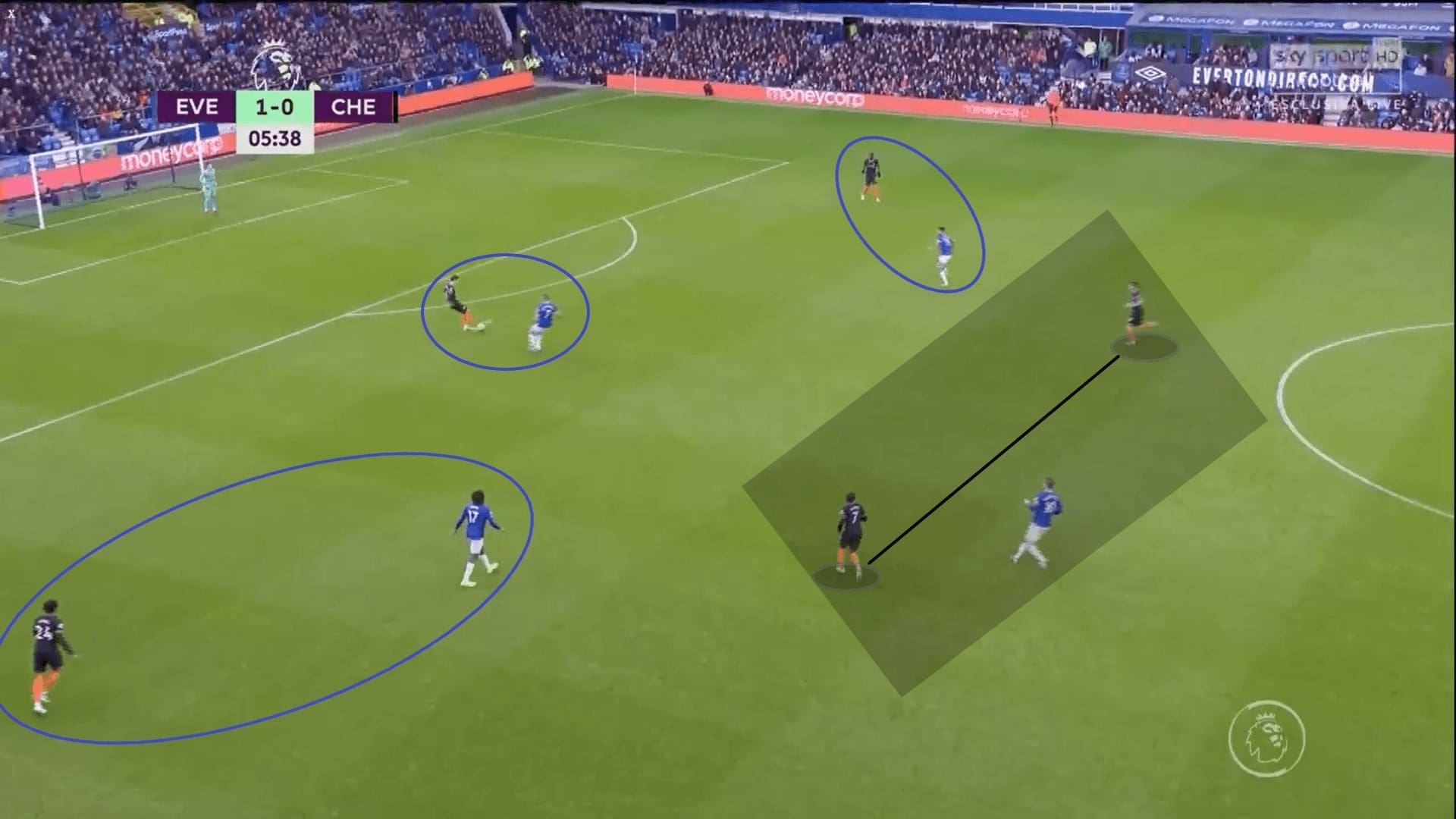
In this scenario, we explained the defence of Everton in their own half. There few points to notice. First, it was the intensive pressing of Everton players, they intended to lock Chelsea wide by committing their midfielders to defend. Therefore, at the right side of the pitch, which a tight area, Everton got four players to defend four Chelsea players. Hardly could Chelsea perform quick combinations to get behind the full-backs. They forced Chelsea to pass the ball back.
However, this approach also had its flaws. If we looked into the horizontal distance of players, the half-spaces of Everton left opened, since Digne left his position; those space could have been exploited. Meanwhile, at the centre of the pitch, Everton left themselves in a three v three situation, if Chelsea played the ball to the centre, they were in danger. Fortunately, the attack of Chelsea were stubborn in the first half, Jordan Pickford was not busy at all.
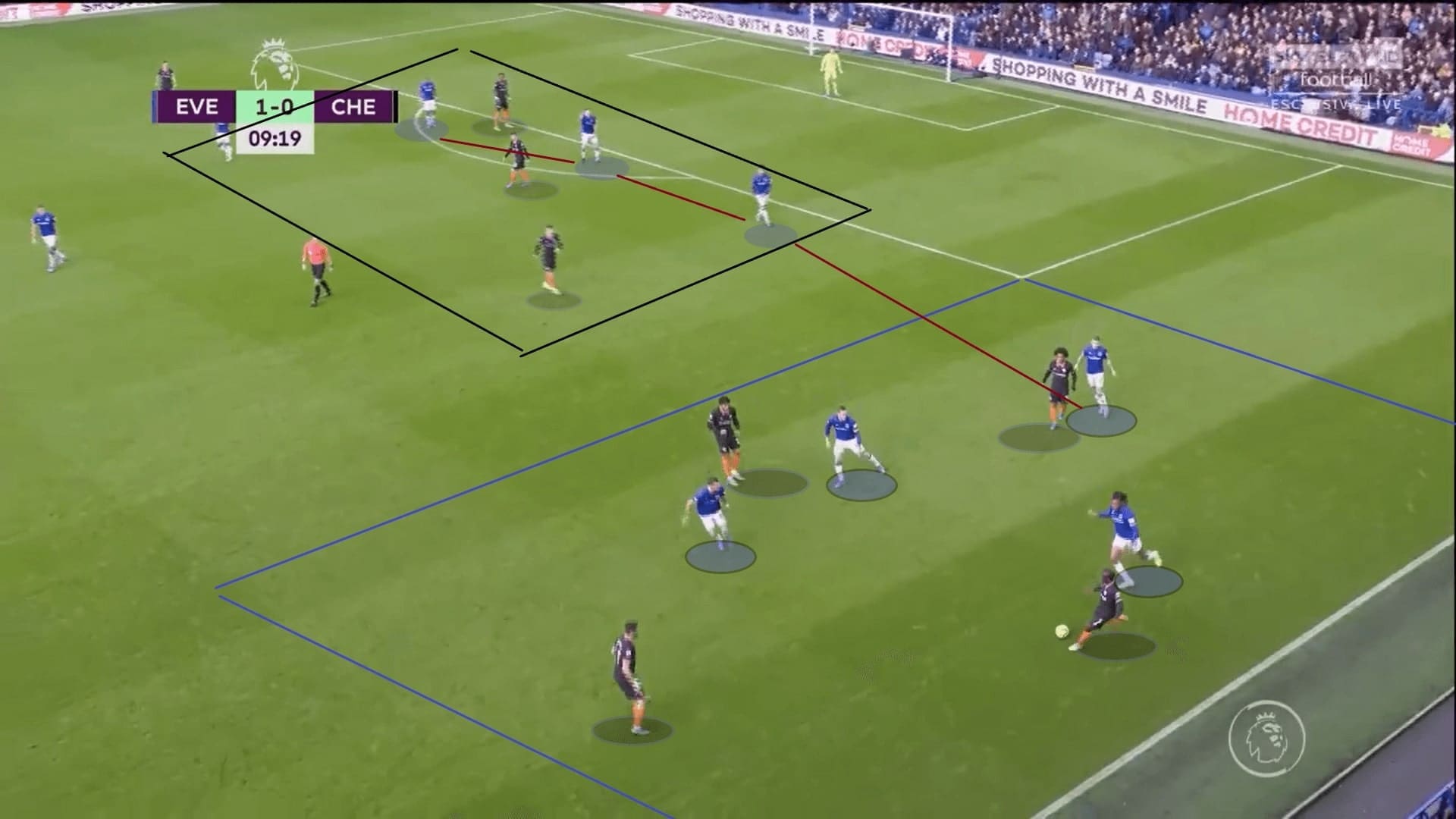
How Chelsea dealt with the opponents’ defence
After explained the defence of Everton, we are going to see how Chelsea tried to get away from the press. Everton players tried to say compact, which left the wide areas opened; Chelsea tried to capitalize on this by playing diagonal balls, they wished to eliminate the first two lines of Everton defence, including the below scene. By staying between the centre backs, Mateo Kovačić was the unmarked player. The Croatian got time to face the goal, observed Azpilicueta on the left side of the pitch. Therefore, the former Real Madrid player tried a diagonal pass to find Azpilicueta, though he failed to find the Spaniard. On other occasions, the Chelsea centre backs also tried the same, but in this domain, Chelsea got to improve, the passes were not accurate enough or comfortable enough for the wide players.
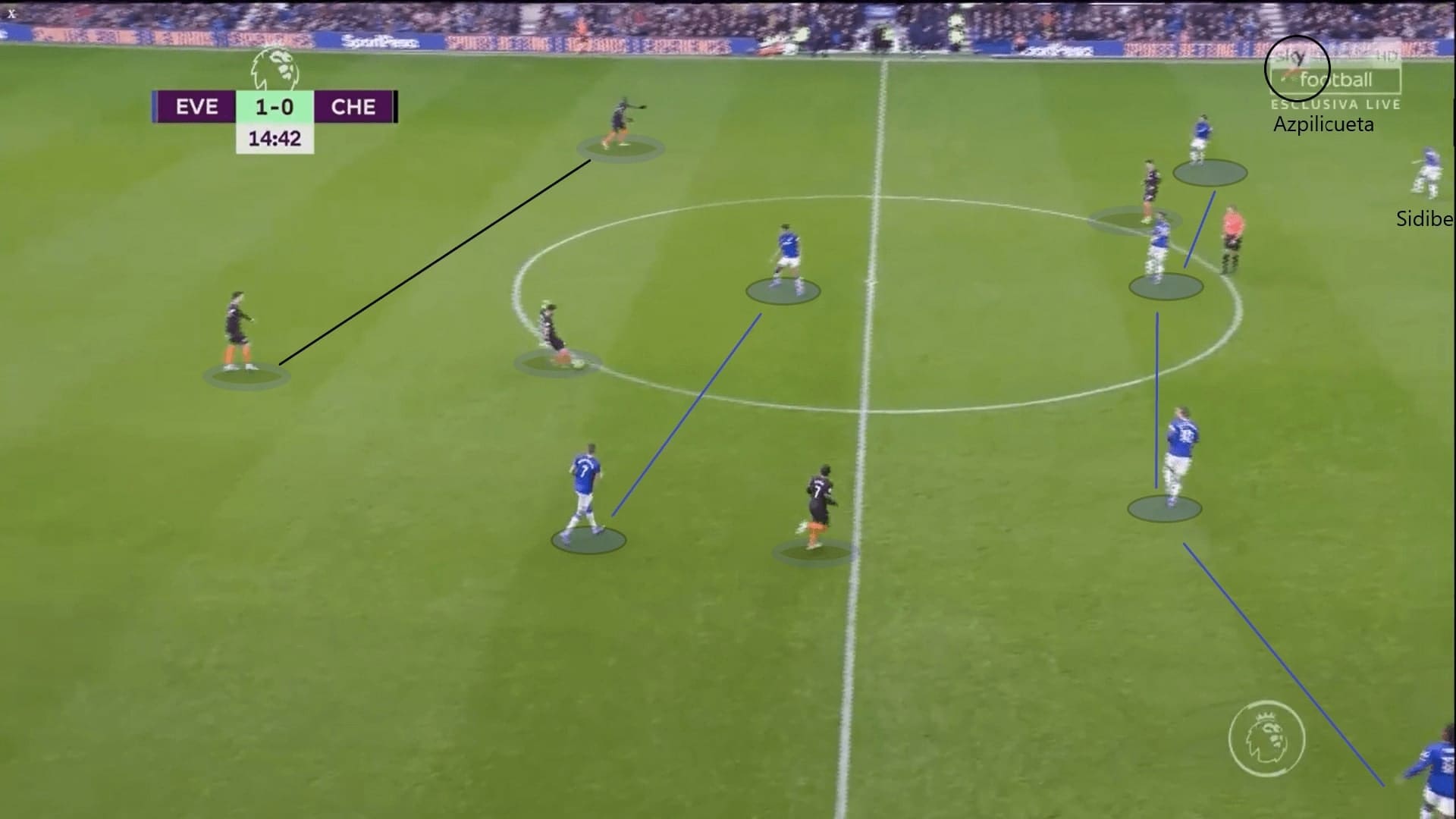
The second way was to play out quickly from the back, as shown below. Chelsea enjoyed a numerical superiority in the first phase of the attack. The centre backs and the pivots overloaded two Everton strikers; when an Everton midfielder stepped out, spaces generated behind him. The key was to play out from the back quickly, that forced Everton players to react instead of giving time for them to anticipate. With the numerical advantage, Chelsea quickly moved the ball under Kovačić’s feet; the Croatian took Schneiderlin out of his position, then Christian Pulisic exploited those space; Chelsea successfully broke Everton press, but when they reached their front players, Everton defenders closed off Tammy Abraham intensively and regained possession. This case was a rare occasion in the first half since Chelsea players lacked confidence and courage to play quickly within the Everton block.
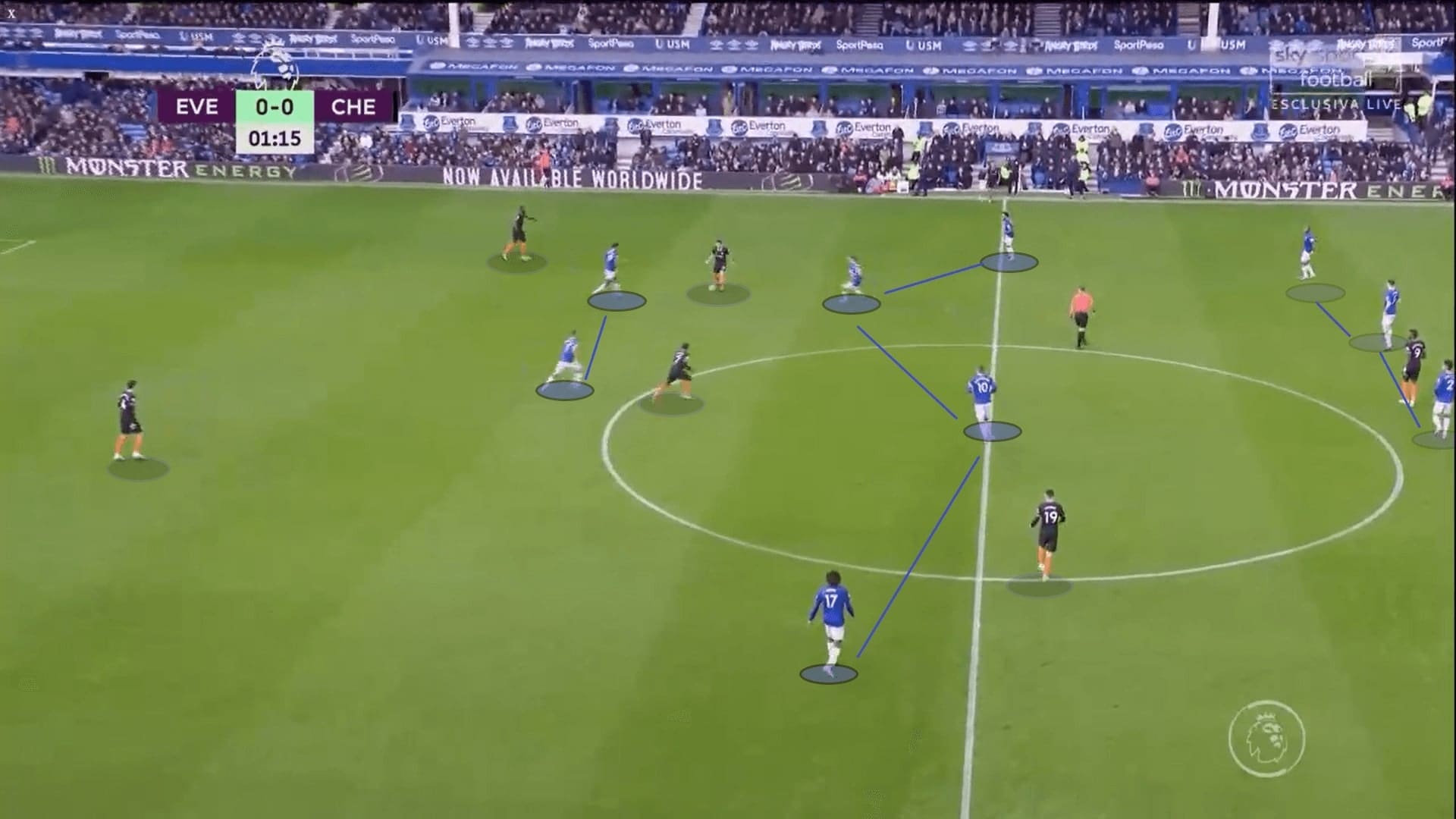
The attack of Everton
Everton looked like a completely different team in this match than previous, they also abandoned the build-up plays of Silva, shifted to play quick direct footballs. The two strikers, Richarlison and Calvert-Lewin were the targets to meet Pickford’s long balls, which became the most effective way for Everton to create their chances.
Everton players were alert to pick second balls in this game, this allowed them to receive layoffs from teammates. One of the Everton strikers would try to win the ball in the air by running from the Chelsea defensive line, usually, that was Calvert-Lewin; he attempted 21 aerial duels and won 43% of them.
This approach took one Chelsea defender out of possession, disrupted their defensive shape, included the following case. Richarlison and Zouma fought for the ball, while Calvert-Lewin stayed alert for the second ball. Meanwhile, Chelsea left their wide areas opened, allowed Everton to exploit those spaces. Another benefit of this approach was they took the Chelsea pivots out of the defence, as both N’golo Kanté and Kovačić positioned higher; when Chelsea attempted a cross, they did not track runs, which we will illustrate below.
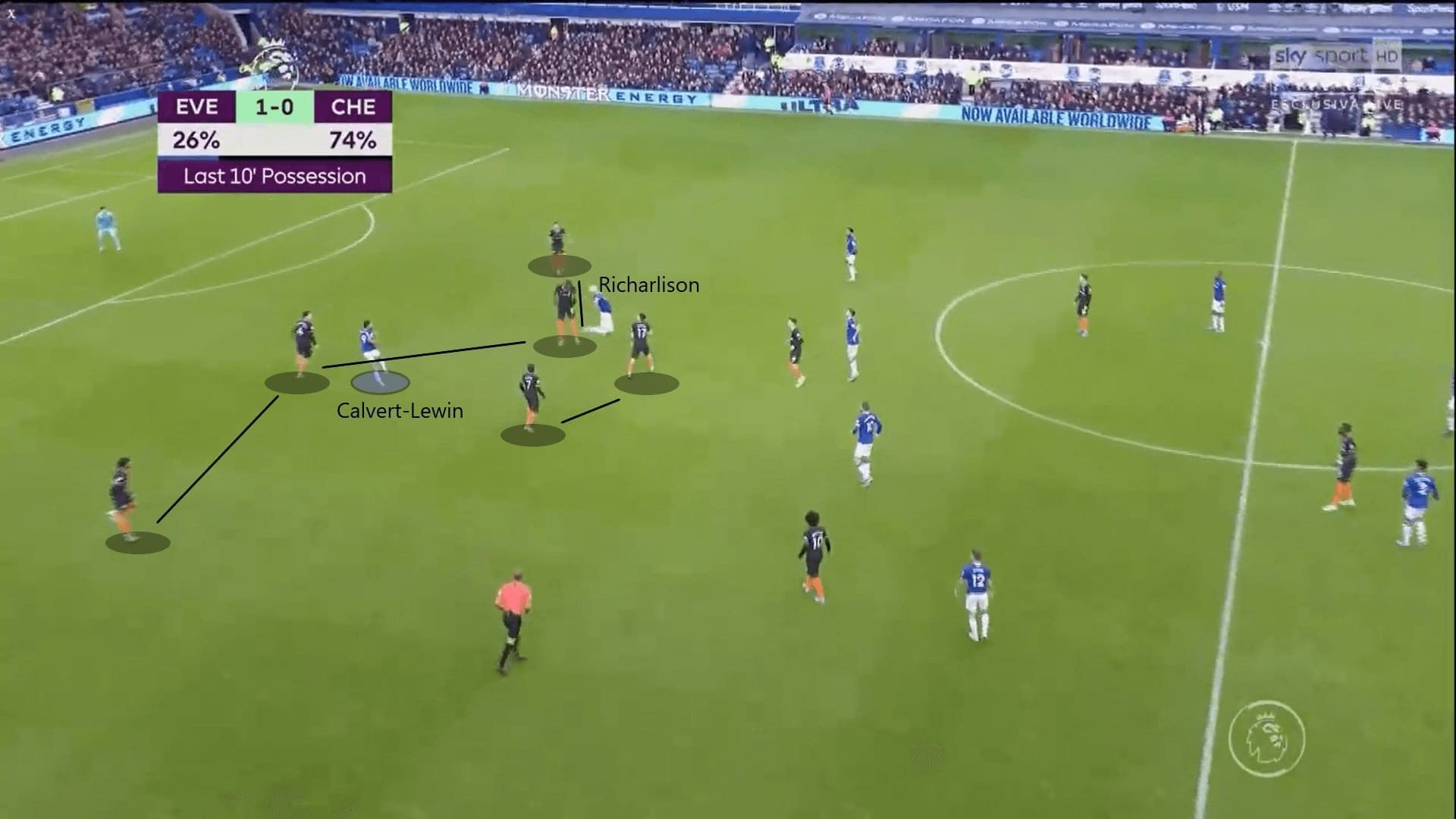
The two following graphs summarized all the passes made by Pickford in the match. It was a little wonder to see the number of long passes compared to the short one. Clearly it was the instruction of Ferguson, to ask the goalkeeper play long, find Calvert-Lewin, and create an attack. Statistics reflected, which 68% of his long passes were trying to find Calvert-Lewin.
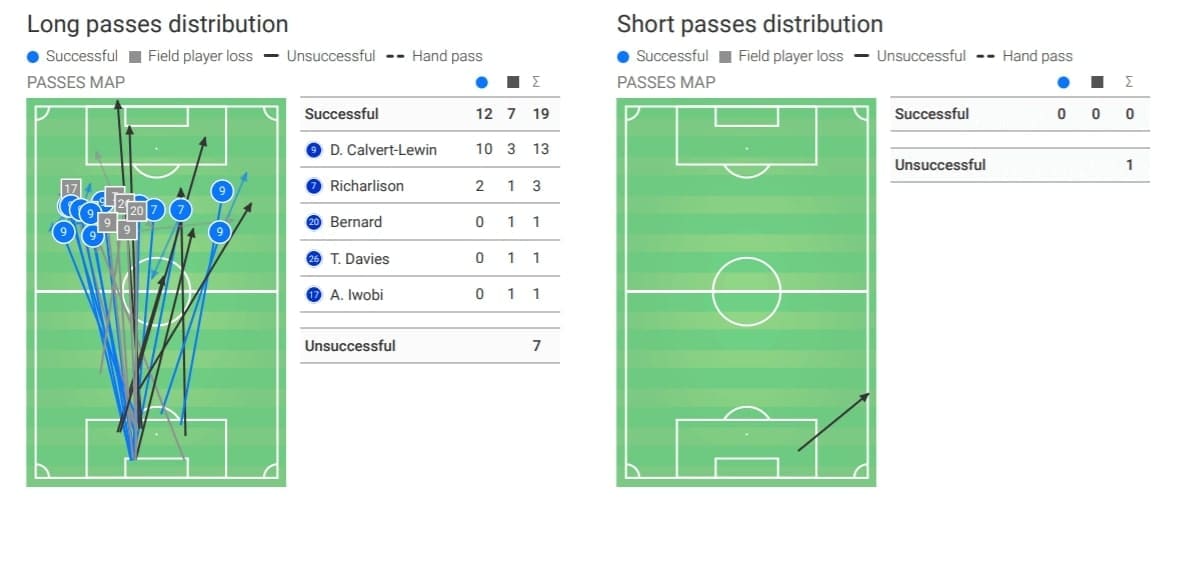
Instead of central penetrations, Everton created their chances through crosses in this game. Ferguson also planned to cross wisely, by utilizing a third-man forward run into the box. He instructed two players to pinned Zouma and Christensen, while a wide player dragged the full-back out. The need of early cross was mandatory since they tried to attack the goal before Kovačić and Kanté to mark the free player who made the forward run. Apart from the free header scored by Richarlison, this case also showed the elements of the approach.
This attack followed the above system, which Pickford played long, then Calvert-Lewin won the ball in the air, also took away Azpilicueta; Walcott received the lay off from the 22-year-old English forward and he put an early cross into the box. Please notice the run of Iwobi, which both Chelsea pivots were unaware of and failed to track him. This time the cross did not find players in the box.
These occasions sustained in the second half as well, which Tom Davies got a chance to score from Digne’s cross.
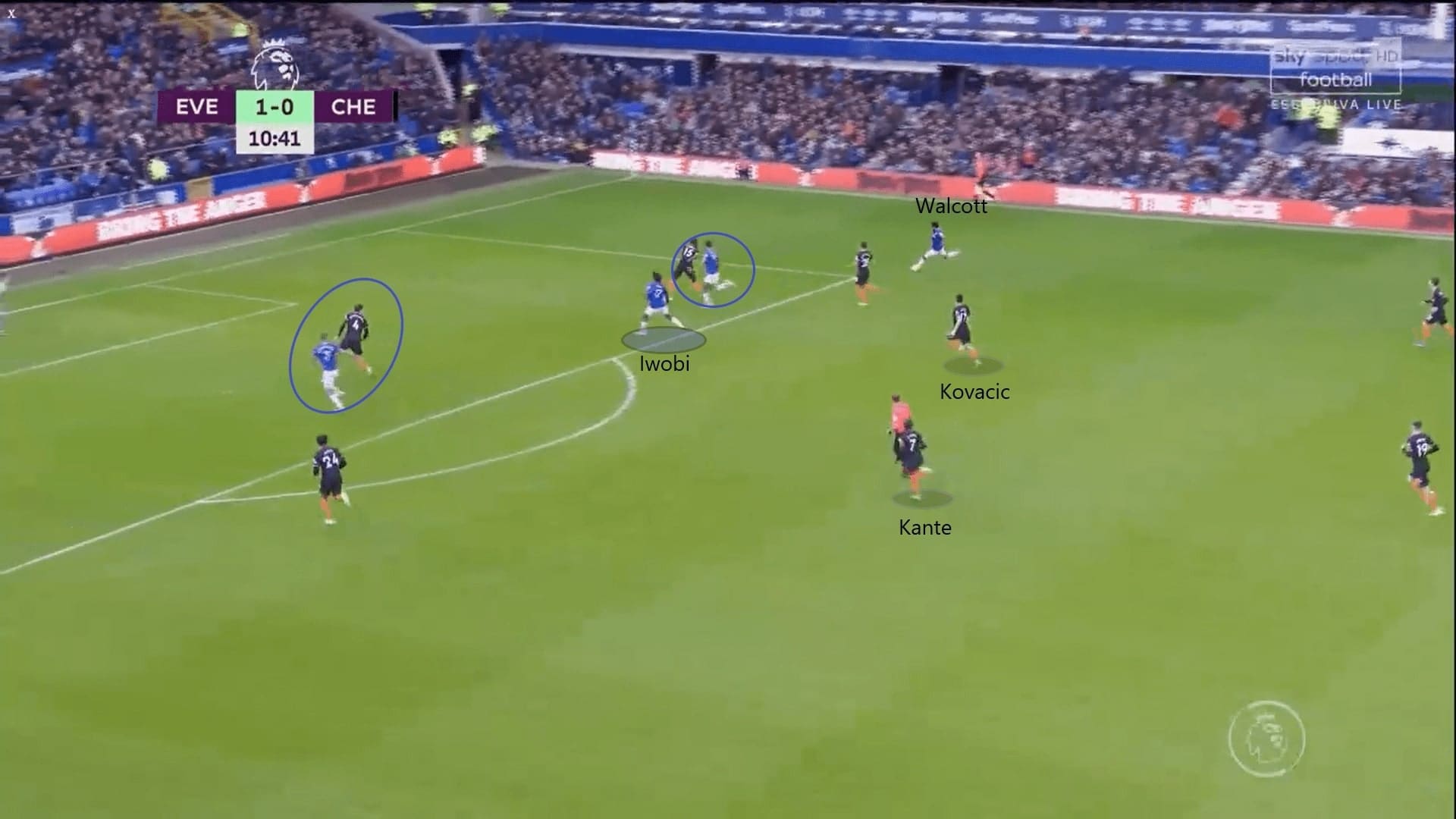
Lampard tried to fix the attack after the break
Chelsea needed goals, given to the low effectiveness of the attack in the first half, Lampard adjusted his tactics, one of them was the duty of Kanté. For the first 45 minutes, the French stayed deeper to help the build-up; in contrast, he moved into an advanced position in the final third more by making diagonal runs or forward runs. The runs were made behind the defenders, and Chelsea players would try to pick him with long balls.
As the following case showed, Kanté began his run between Iwobi and Schneiderlin, while his midfield partner Kovačić noticed that. Since the Everton players were focusing on the ball rather than marking players, the French easily got behind of Keane and created a shooting chance for Mason Mount.
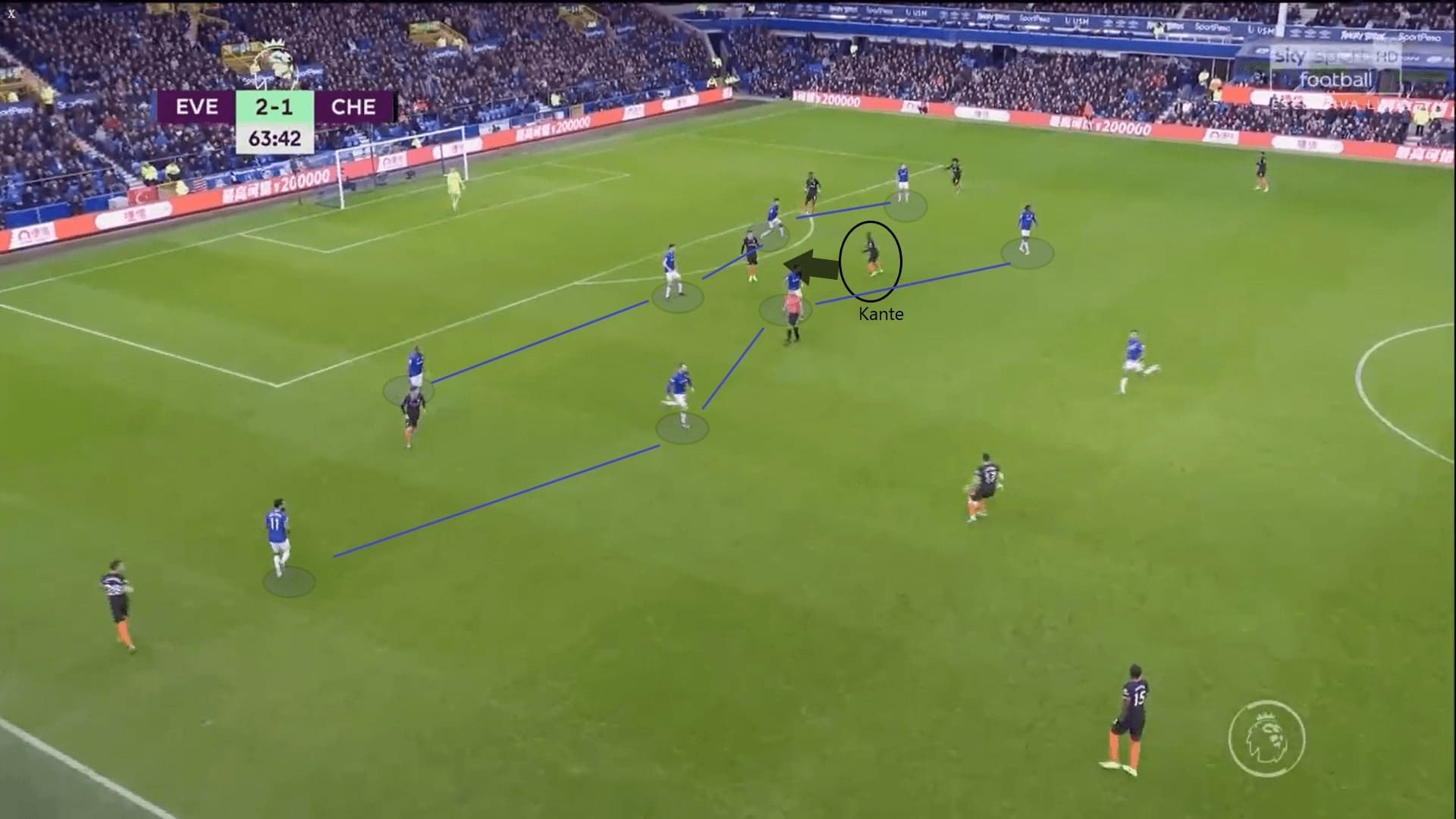
Speaking of Mount, he was quite in the first half, which could be attributed by Chelsea’s failure to reach the final third. The English midfielder only got 21 passes in the first half, this figure increased to 34 in the second half, apparently, Lampard wanted Mount to involve more. Mount did it by dropping more to the midfield, especially when Kanté moved into an advanced position.
The dropping movements of Mount allowed him to receive the ball without pressure, as the Everton players decided to maintain their defensive shape instead of following a front player who dropped deep. As showed below, Mount faced the goal, once again, Kanté made the diagonal run, and Mount picked him to help Chelsea reaching the final third.
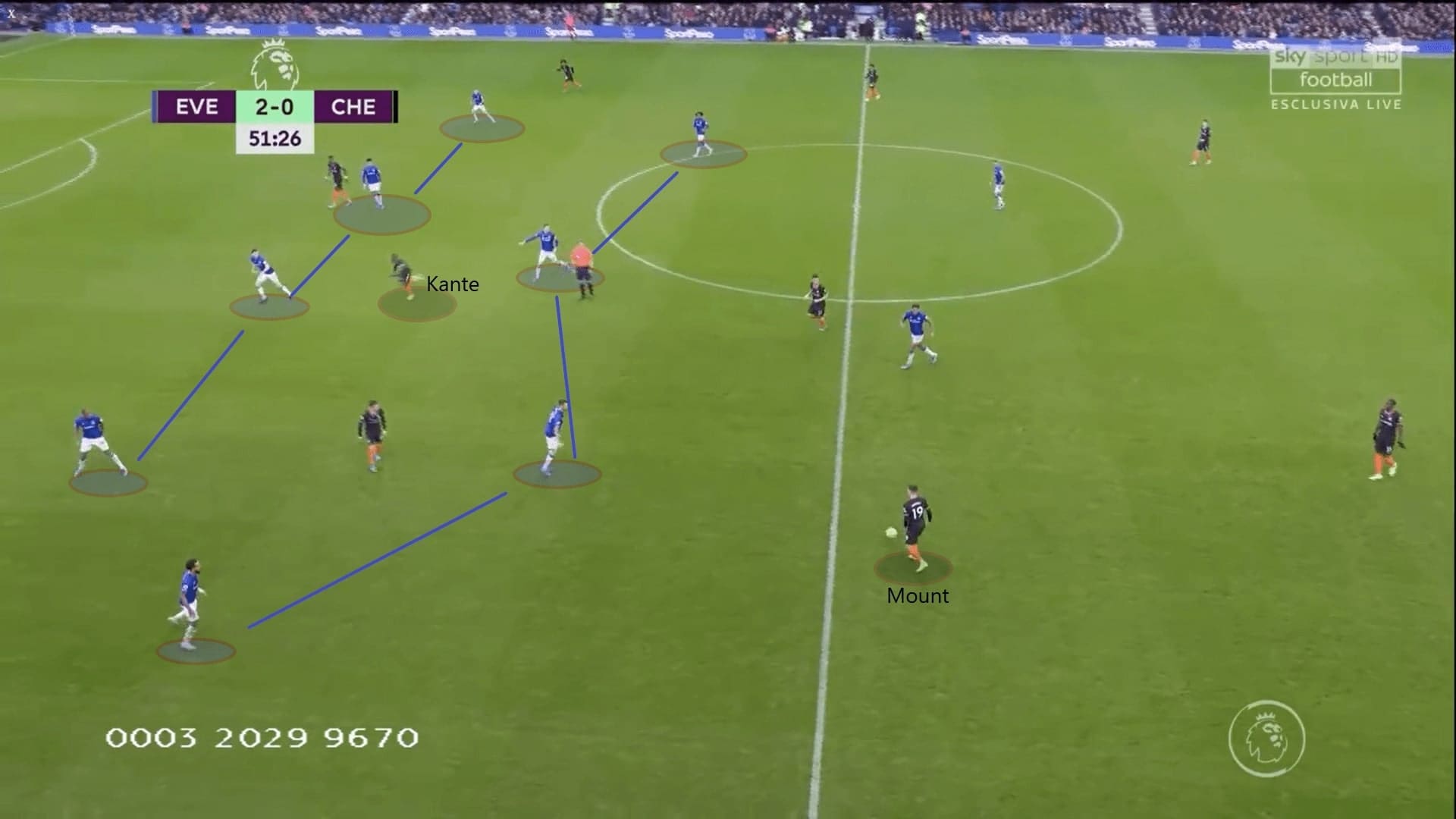
Despite the wingers defending deeper in the second half, Everton still got their chances to win the ball high up on the pitch. It seemed Lampard encouraged his pivots to get the ball on their feet more, so Kovačić got plenty of rooms to receive the ball. However, this became a problem of Chelsea as the Croatian sometimes dribbled too much on the pitch and lost the ball in a dangerous position. This happened three times in the second half, which Kovačić dribbled unnecessarily and lost the ball.
This scenario was Kovačić won the duel against Davies, but he intended to keep dribbling instead of passing the ball, which Kepa Arrizabalaga and Zouma were both available for a pass. Meanwhile, it seemed the Croatian did not notice the presence of Callum Hudson-Odoi who stayed on the right side of the pitch. A heavy touch from Kovačić allowed Calvert-Lewin to win the ball back high up on the pitch, then Everton quickly developed this into a shooting chance.
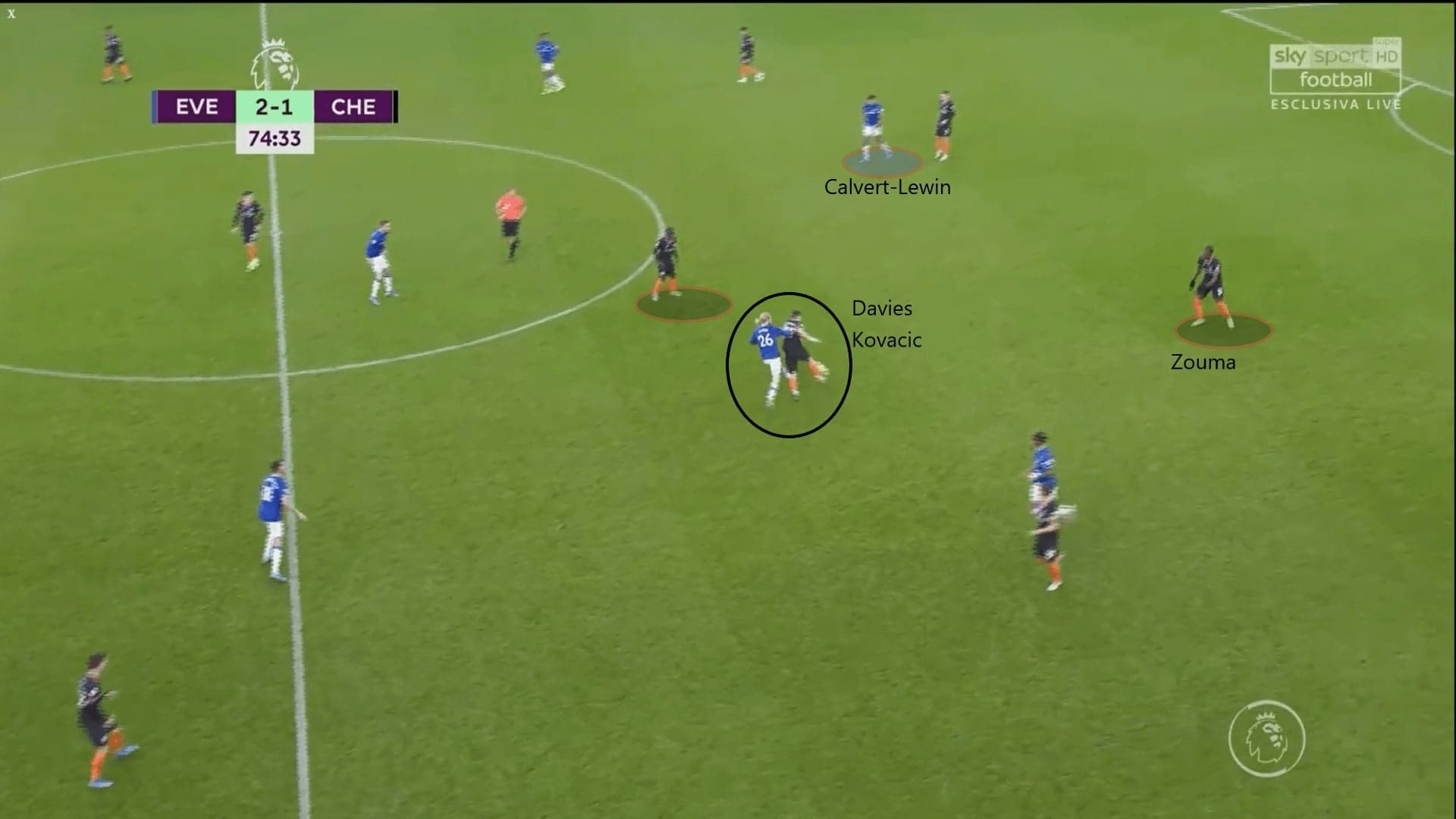
In the second half, Everton defended deeper, with the huge numbers of players defending deep, despite Chelsea reached the attacking third more, they hardly could create clear-cut chances. The individual errors were decisive to the results, as both goals from Calvert-Lewin could have been avoided.
For the defensive aim of Everton, in the first half, they were trying to win the ball more frequently to start an attack; after the break, they tried to delay Chelsea’s attack since they already scored goals. The attack per minutes of Chelsea was increased from 0.51 to 0.63 in the second half.
Conclusion
This game was a huge boost for Everton, no matter Ferguson would continue to coach the team or not. It was quite surprised to see Everton changed completely, from the attack to their defence; they played in a higher tempo, very direct football, intensive pressing, deserved to take all the points. Apart from the front players, Sidibé should be applauded as well, the Frenchman was heavily involved in the game, with 33 passes and 24% of them were passed into the final third (more than any other Everton players). Defensively, he was involved in 22 defensive duels and won 14 of them. We do not know who is going to be the next Everton manager yet, but these players proved they are capable of doing better.
It was a disappointing game for Chelsea and Lampard, maybe the manager was questioned for the decision of benching Tomori. Despite the individual errors at the defence, the attack of Chelsea was not sharp enough; they also had to do better in terms of picking second balls. Still, there was a long way to go for Lampard to fully transform the team.

If you love tactical analysis, then you’ll love the digital magazines from totalfootballanalysis.com – a guaranteed 100+ pages of pure tactical analysis covering topics from the Premier League, Serie A, La Liga, Bundesliga and many, many more. Buy your copy of the December issue for just ₤4.99 here





Comments